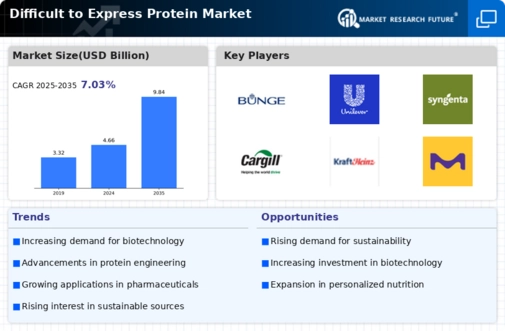Market Growth Projections
The Global Difficult to Express Protein Market Industry is characterized by robust growth projections. With a market valuation of 4.66 USD Billion in 2024, the industry is anticipated to expand significantly over the next decade. The projected CAGR of 7.03% from 2025 to 2035 indicates a sustained upward trajectory, driven by various factors, including technological advancements and increasing demand for biopharmaceuticals. This growth is likely to be accompanied by the emergence of new players in the market, further enhancing competition and innovation. As the industry evolves, stakeholders are expected to adapt to changing market dynamics, positioning themselves for future opportunities.
Rising Demand for Biopharmaceuticals
The Global Difficult to Express Protein Market Industry is experiencing a surge in demand for biopharmaceuticals, which are increasingly reliant on complex proteins. As therapeutic proteins become more prevalent in treating chronic diseases, the need for effective expression systems grows. In 2024, the market is valued at 4.66 USD Billion, reflecting the industry's expansion. The complexity of these proteins often leads to challenges in expression, thereby driving innovation in expression technologies. This trend is expected to continue, with projections indicating that by 2035, the market could reach 9.84 USD Billion, suggesting a robust growth trajectory fueled by advancements in biopharmaceutical development.
Increasing Investment in Biotechnology
Investment in biotechnology is a significant driver of the Global Difficult to Express Protein Market Industry. Governments and private entities are channeling funds into research and development to foster innovation in protein expression technologies. This influx of capital is crucial for developing new methodologies that can address the challenges associated with difficult-to-express proteins. For instance, initiatives aimed at enhancing the efficiency of expression systems are gaining traction, which could lead to breakthroughs in therapeutic applications. As the market evolves, the financial commitment to biotechnology is likely to bolster growth, contributing to the projected market value of 9.84 USD Billion by 2035.
Regulatory Support for Biopharmaceuticals
Regulatory support is a crucial factor influencing the Global Difficult to Express Protein Market Industry. Governments worldwide are recognizing the potential of biopharmaceuticals and are implementing favorable regulations to expedite the approval process for new therapies. This supportive environment encourages investment in the development of difficult-to-express proteins, as companies seek to navigate regulatory pathways more efficiently. As regulatory frameworks evolve, they are likely to facilitate the introduction of innovative protein-based therapies into the market. This trend is expected to contribute to the industry's growth, with the market projected to reach 9.84 USD Billion by 2035.
Growing Applications in Research and Development
The Global Difficult to Express Protein Market Industry is witnessing an expansion in applications across various research and development sectors. The increasing focus on personalized medicine and targeted therapies necessitates the production of complex proteins for research purposes. As academic and industrial research institutions strive to develop novel therapeutics, the demand for difficult-to-express proteins is likely to rise. This trend is evident in the growing number of collaborations between research institutions and biotechnology firms, aimed at overcoming expression challenges. Consequently, the market is poised for growth, with a projected CAGR of 7.03% from 2025 to 2035, reflecting the increasing importance of these proteins in R&D.
Technological Advancements in Protein Expression
Technological advancements play a pivotal role in shaping the Global Difficult to Express Protein Market Industry. Innovations in genetic engineering, such as CRISPR and synthetic biology, are enhancing the ability to express challenging proteins. These technologies enable researchers to manipulate genetic sequences more efficiently, leading to higher yields and improved protein quality. As a result, companies are increasingly investing in these technologies to overcome the hurdles associated with difficult-to-express proteins. The anticipated compound annual growth rate (CAGR) of 7.03% from 2025 to 2035 indicates a growing recognition of the importance of these advancements in meeting market demands.





















Leave a Comment